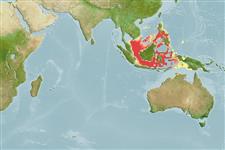Пластиножаберные (акулы и скаты) (sharks and rays) >
Carcharhiniformes (Ground sharks) >
Pentanchidae (Deepwater catsharks)
Etymology: Halaelurus: halos (Gr.), sea; ailouros (Gr.), cat, probably an allusion to the vernacular “catshark,” so named for its cat-like eyes (See ETYFish); maculosus: Latin for speckled, referring to speckling of small dark spots over dorsal and lateral surfaces of body (See ETYFish).
More on authors: White, Last & Stevens.
Environment: milieu / climate zone / пределы глубины / distribution range
экология
морской демерсальный. Tropical
Pacific Ocean: known from the southern coast of Java, and off the islands of Bali and Lombok in eastern Indonesia, and has also been recorded from several landing sites in the Philippines (Ref. 59315).
Size / Вес / Возраст
половая зрелость: Lm ? range ? - ? cm
Max length : 45.7 cm TL самец/пол неопределен; (Ref. 59315); 52.8 cm TL (female)
Краткое описание
определительные ключи | морфология | морфометрия
Small adult size; Body tapering, anterior trunk wide and somewhat depressed; tail long and slender, almost circular in cross-section at second dorsal-fin insertion; no lateral keels; no postnatal ridge between anal fin base and lower caudal-fin origin; no longitudinal ridges on dorsal surface, no obvious lateral ridges. Head short, wide and somewhat depressed, more so between eyes and ventrally; narrowly pointed, not upturned or knob-like in lateral view (slightly upturned in some paratypes); in dorsoventral view anterior to gill openings broadly parabolic; subocular ridge evident, variably angular. Eyes small, spindle-shaped; dorsolateral on head, with lower edges well medial to lateral head margin in dorsal view; subocular ridges weak, not well defined, subequal in length to eye, almost a spiracle length from eye margin; no supraorbital crest (Ref. 59315).
Body shape (shape guide): elongated.
Reported to be caught occasionally by demersal fisheries, but no depth distribution information is available (Ref. 59315).
Life cycle and mating behavior
половая зрелость | размножение | нерест | икра | Fecundity | личинки
White, W.T., P.R. Last and J.D. Stevens, 2007. Halaelurus maculosus n. sp. and H. sellus n. sp., two new species of catshark (Carcharhiniformes: Scyliorhinidae) from the Indo-West Pacific. Zootaxa 1639:1-21. (Ref. 59315)
Статус Красного Списка МСОП (Ref. 130435: Version 2025-1)
Угроза для людей
Harmless
Использование человеком
дополнительная информация
инструменты
Специальные отчеты
Скачать в формате XML
ресурсы в Интернет
Estimates based on models
Preferred temperature (ссылка
123201): 22.2 - 28.4, mean 27.4 °C (based on 51 cells).
Phylogenetic diversity index (ссылка
82804): PD
50 = 0.5078 [Uniqueness, from 0.5 = low to 2.0 = high].
Bayesian length-weight: a=0.00355 (0.00175 - 0.00721), b=3.08 (2.90 - 3.26), in cm total length, based on LWR estimates for this (Sub)family-body shape (Ref.
93245).
Trophic level (ссылка
69278): 4.4 ±0.5 se; based on size and trophs of closest relatives
устойчивость к внешним воздействиям (ссылка
120179): низкий, минимальное время удвоения популяции 4.5-14 лет (Preliminary low fecundity).
Fishing Vulnerability (Ref.
59153): Moderate vulnerability (41 of 100).
🛈
